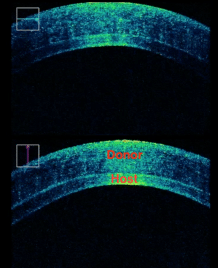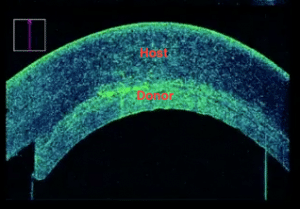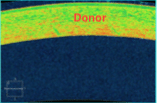There are three types of corneal transplants that are most frequently performed: ALK, DSAEK, and PKP. During your consultation, I will discuss the options that are most relevant and appropriate for you. The following are special images taken during surgery to help you understand the differences between these types of keratoplasty.
ALK

Anterior lamellar keratoplasty (ALK): Front surface transplant
Anterior lamellar keratoplasty (ALK) is used to replace the front most layers of the cornea. It is often used to treat hereditary corneal cloudiness that affects the middle layers of the cornea and thinning conditions of the cornea like keratoconus. It does not treat corneal swelling (edema).
ALK surgery normally takes less than one hour to perform and allows return to normal activities in approximately one week. Visual recovery usually takes six months and requires the use of specialty (scleral) contact lenses for best vision.
The advantages of ALK include a very strong wound and decreased rejection risk (1%).
DMEK / DSAEK

Descemet’s Stripping Automated Endothelial Keratoplasty (DSAEK): Back surface transplant
Endothelial keratoplasty know as Descemet’s Membrane Endothelial Keratoplasty (DMEK) or Descemet’s Stripping Automatic Endothelial Keratoplasty (DSAEK) is used to replace the back most layer of the cornea. It is often used to treat corneal swelling after previously complicated surgeries or Fuchs’ dystrophy.
DMEK and DSAEK surgery normal take fifteen minutes and allow return to normal activities in approximately two days. These are unique in that they requires laying flat on one’s back for one hour after surgery. Visual recovery usually takes two to three months and often allows for use of glasses after surgery rather than a contact lens.
The advantages of DMEK and DSAEK over PKP for corneal swelling include short surgical time, less need for contacts, and reduced rejection risk (3%).
PKP

Penetrating Keratoplasty (PKP): Full thickness transplant
Penetrating keratoplasty (PKP) is used to replace all layers of the cornea. It is often used to treat full thickness opacities and corneal swelling when DSAEK is not a option.
PKP surgery normally takes one hour and allows return to normal activities in approximately one week. Like ALK surgery, visual recovery usually takes six months and requires the use of speciality (scleral) contact lenses for best vision.
The advantages of PKP include full thickness corneal clarity. It however has the highest rate of rejection (20%) and is most susceptible to trauma.
I’m happy to serve the Houston Metroplex and its surrounding areas and look forward to helping with your corneal condition.


